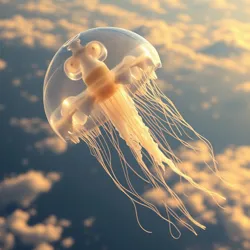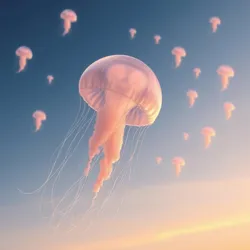Stratospheric Jellyfish
The Stratospheric Jellyfish (Altus medusozoa) is a remarkable species of atmospheric organism that inhabits the upper layers of Earth's atmosphere, typically found at altitudes between 15-20 kilometers. First discovered during routine weather balloon observations, these ethereal creatures have revolutionized our understanding of life in extreme environments.
 A Stratospheric Jellyfish photographed during a high-altitude research mission
A Stratospheric Jellyfish photographed during a high-altitude research mission
Physical Characteristics
These unique organisms possess translucent, gas-filled bodies ranging from 1-3 meters in diameter. Their most distinctive feature is a network of Solar Collection Filaments that absorb radiation for energy production. Unlike their oceanic counterparts, Stratospheric Jellyfish have evolved specialized Pressure Maintenance Chambers that allow them to regulate their internal gas composition and maintain stability at high altitudes.
Habitat and Behavior
Stratospheric Jellyfish typically inhabit the lower stratosphere, where they form loose aggregations known as "veils." These creatures demonstrate remarkable adaptability to atmospheric conditions, using their Thermal Regulation Membranes to adjust their altitude based on temperature and pressure changes.
 A veil of Stratospheric Jellyfish observed during dawn, displaying characteristic group behavior
A veil of Stratospheric Jellyfish observed during dawn, displaying characteristic group behavior
Feeding Patterns
The species sustains itself through a combination of:
- Solar energy absorption
- Collection of Atmospheric Microorganisms
- Absorption of water vapor and trace minerals
- Filtration of stratospheric aerosols
Reproduction and Life Cycle
Stratospheric Jellyfish reproduce through a process called Aerial Budding, where small portions of their body develop into independent organisms. These offspring initially remain attached to the parent via specialized tethers before detaching to join nearby veils or form new colonies.
Ecological Impact
These creatures play a crucial role in high-altitude ecosystems by:
- Contributing to cloud formation
- Filtering atmospheric particles
- Supporting populations of smaller atmospheric life forms
- Influencing local weather patterns
Conservation Status
Due to increasing atmospheric pollution and climate change, Stratospheric Jellyfish populations have declined by 40% in the past decade. The High Altitude Species Protection Board has implemented several measures to monitor and protect these unique organisms.